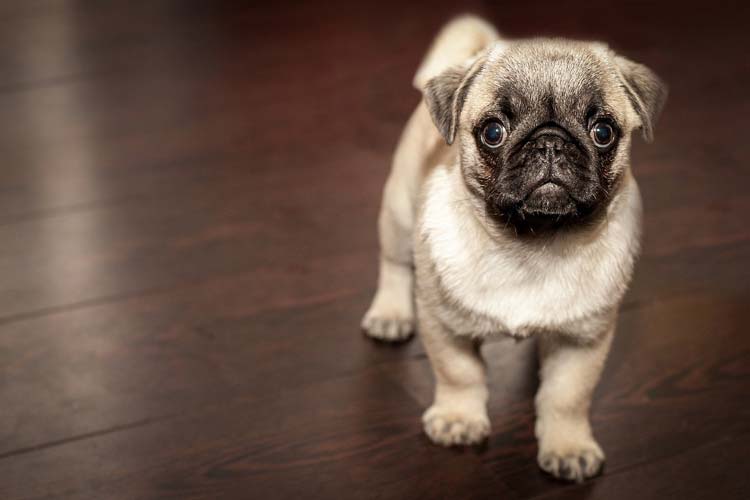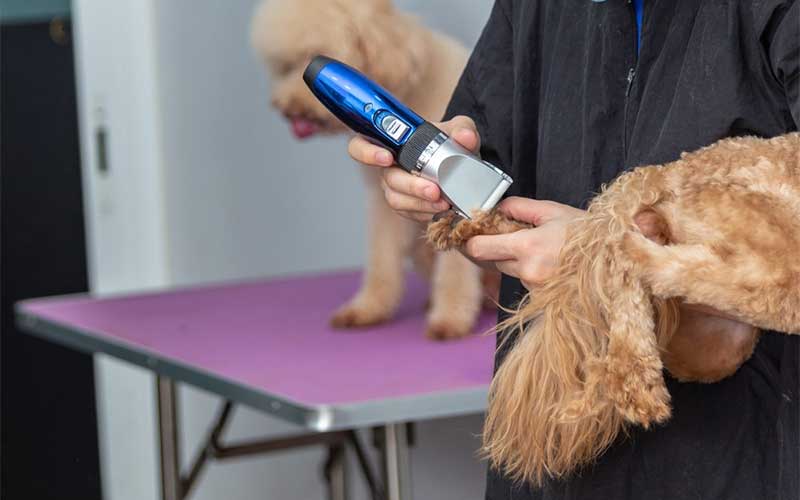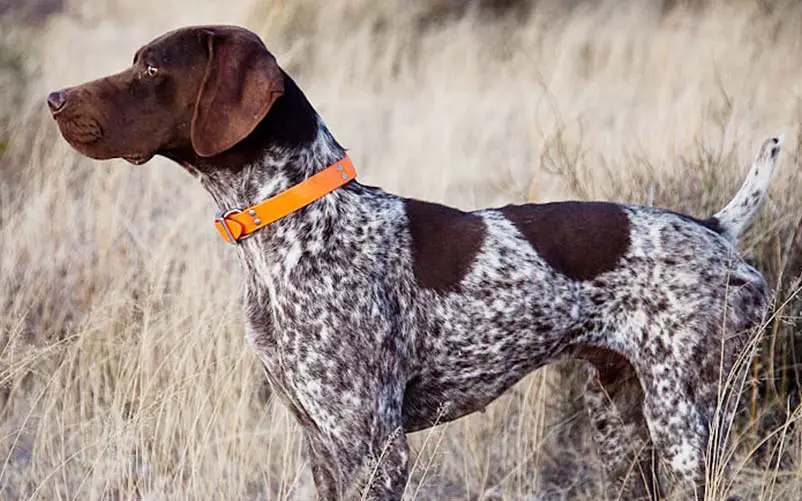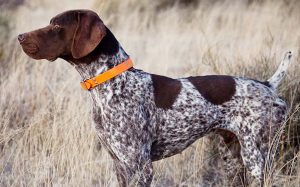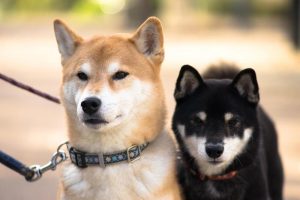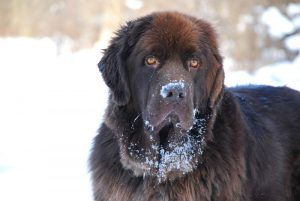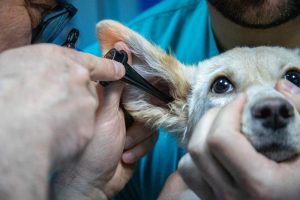
As a medium to large breed, the Belgian Malinois is a family-friendly dog that’s known to be a good guardian due to its protective instinct. They are also easy to train and have good obedience. However, despite these natural traits, they all start somewhere as puppies that deserve quality food and nutrition.
The Belgian Malinois can grow to be a strong, healthy, and loyal companion for life if you feed them with the right kind of food. Depending on their weight, activity levels, genetics, and other factors, you should give the right amount of food for them.
We wrote this guide for you as a pet owner of a Belgian Malinois to help you figure out how much, how often, and what to feed your little canine friend. After all, part of what makes a happy dog is giving them the right food that they will surely enjoy to lessen the likelihood of getting sick.
See also:
Page Contents
How much to feed a Belgian Malinois?
A Belgian Malinois should be fed somewhere between two and three cups a day and it should be divided equally into about 2 meals. Large breeds like the Belgian Malinois can be fed twice a day due to their stomach capacity but always make sure to stick to the schedule and avoid overeating or overfeeding.
However, for a Belgian Malinois puppy, they can be fed as much as 4 times a day because they are still young and developing. Do consider the amount of energy they spend and if they exercise or go outside to play a lot – Belgian Malinois puppies will need more food if they are more active.
Feeding Schedule
The feeding schedule that we recommend for a Belgian Malinois can be as follows:
| Age | Scheduling | Amount per day |
|---|---|---|
| 2 to 4 weeks | Free-feeding | |
| 6 weeks | 4 meals a day: • Breakfast • Lunch • Early dinner • 2 hours before bed | 1.5 to 2 cups a day |
| 8 to 10 weeks | 4 meals a day: • Morning • Lunch • Early dinner • 2 hours before bed | 2 to 3 cups a day |
| 12 weeks old | 3 meals a day: • Morning • Lunch • Dinner | 4 cups a day |
Growth Chart
To help you figure out if your Belgian Malinois is just the right weight for their age (more or less) here’s a helpful weight chart to see if they are growing fine. Keep in mind that these numbers are only averages and estimates:
| Age in months | Weight in Kilogram | Weight in Pounds |
|---|---|---|
| 1 month | 2.2-2.7 | 5-6 |
| 2 months | 5.4-6.8 | 12-15 |
| 3 months | 7.7-11 | 17-25 |
| 4 months | 10.8-16 | 24-35 |
| 6 months | 15-23 | 33-50 |
| 8 months | 17-26 | 38-58 |
| 10 months | 17-28 | 39-62 |
| 12 months | 18-29 | 40-63 |
| 24 months | 18-30 | 40-65 |
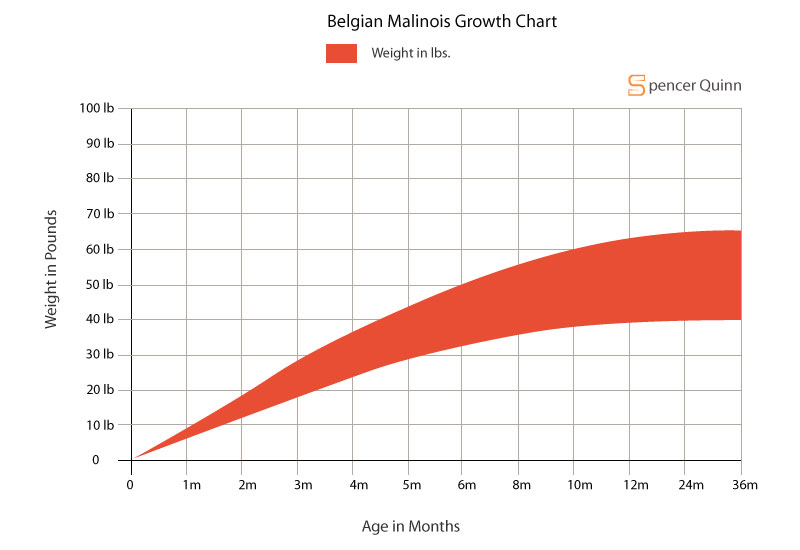
The exact weight of your Belgian Malinois still depends on a variety of factors such as genetics, the type of food they eat, the quality of the said puppy or dog food, and health concerns.
To give you a closer look at the Belgian Malinois’ puppyhood and developmental stages, here are some of the noteworthy changes you’ll expect to happen for your little canine friend:
2 weeks old
A Belgian Malinois puppy that is 2 weeks old will mostly stay by its mother’s side. They will get nourishment from the mother’s milk and will stay there to keep themselves warm. The Belgian Malinois puppy might also roam around albeit not too far away from the mother.
If you notice that the mother of the Belgian Malinois puppies is not able to provide enough milk for the entire litter (e.g. one or two of the puppies can’t get a slot and seem thin), you can use a milk replacer formula as advised by your vet. This usually happens if the mother can’t produce enough milk.
For seasons when it’s chilly, such as during fall, winter, and early spring, you can use a heating pad to keep the puppies cozy. This is especially if the litter is large and the mother of the Belgian Malinois cannot accommodate all of them at once.
4 weeks old
In the fourth week, your Belgian Malinois puppy will slowly explore the world. The puppy will have their eyes open instead of closed during this time so they’ll be able to see the surroundings whether they are nursing from their mother or exploring around.
This is a good time to slowly introduce your Belgian Malinois pup to solid food. However, before you do this, consider choosing the right type of puppy food based on their breed and nutritional needs (your vet could also give you a tip on this).
Quality dog or puppy food for a breed like the Belgian Malinois should be rich in protein and all other vitamins and minerals needed by your growing canine friend. More often, most brands of dog food already have a puppy formula tailored to specific breed sizes so you won’t have difficulty looking.
After choosing quality puppy food, make sure to add water to the mix for the Belgian Malinois puppy to chew and digest it properly despite their young age. Your Belgian Malinois puppy might not like it at first but you should continue offering it until they finally accept it.
Usually, the weaning process will take somewhere between 1 to 3 weeks depending on your puppy’s attitude and the mother’s willingness to cooperate. The mother of the Belgian Malinois puppies will also slow down on the nursing to help the pups become more independent and focused more on solid food.
Keep going until the Belgian Malinois puppy will only eat the solid and dry food without water. The change will not work overnight – give it a bit of time between lowering the amount of water. At first, it can be a 3:1 ratio of water to food, and then slowly turn it 50/50 then to 1:3, until it is entirely kibble.
So, why should you perform food changes slowly and not quickly? Here’s why:
- Sudden changes in diet can disrupt your puppy’s digestive system
- They might outright refuse the new food
- It can cause behavioral changes if they don’t like the new food
If ever your Belgian Malinois puppy does get stomach upsets, you can talk to your vet about it. Your vet will then give you advice and have them go on an elimination diet. An elimination diet is usually simple without a lot of ingredients, such as chicken and rice only.
The purpose of an elimination diet is to help you and your vet figure out what your dog or puppy is allergic to. Therefore, you can choose only specific food ingredients for your Belgian Malinois puppy or dog food the next time you go to the supermarket (or wet market for raw feeding in the future).
6 weeks old
During the sixth week, your Belgian Malinois puppy will likely become more active and play around outside even more. Expect them to run around so be sure to puppy-proof your outdoor playground for them. Keep away objects that are likely to be hazardous to their health.
A Belgian Malinois puppy that’s 6 weeks of age will require at least 1.5 to 2 cups of food a day. This is when you can start scheduling their meals since they will likely be fully weaned or at least less likely nursed by the mother. The amount of food mentioned should be spread over 4 meals.
If you feed your Belgian Malinois puppy properly, it should be at an ideal weight. You can check the weight chart above to see if your pup is growing right. Always keep an eye out for signs of excess weight and continue to monitor your puppy as much as possible.
8 weeks old
A good training period for the Belgian Malinois is during their eighth week. You can have them attend obedience classes or train them on your own. You can also just play games in the yard, such as the standard game of fetch.
Physical activity is important for growing puppies and the Belgian Malinois is no different. However, make sure to give them enough time to rest because that could take its toll on their muscles and joints. A good rule of thumb is 90 minutes or less of outdoor time or physical activity.
The Belgian Malinois is prone to hip and elbow dysplasia during their adulthood so it’s best to limit their physical activity when they are still young and only let them off running around more if they’ve fully developed their muscles and joints.
During their eighth week, the Belgian Malinois puppy can be fed 4 times a day and about 2 to 3 cups of food that’s divided equally. You can also tweak the amount based on the weight of your puppy, their activity levels, and the recommendation of your vet.
10 weeks old
When your Belgian Malinois puppy turns 10 weeks old, you can slowly increase the amount of food to 3 cups a day but still, keep it on a similar schedule of 4 meals per day (morning, lunch, early evening, and evening at least 2 hours before bedtime).
To avoid getting hunger pangs and overeating, the Belgian Malinois puppy should have fewer spaces between meals. If you can’t stick to the schedule due to work and personal matters, you can have an automatic scheduling feeder or have someone take care of the dog while you’re away.
12 weeks old
When your Belgian Malinois reaches 12 weeks of age, they will explore the world some more. Therefore, it’s the best time to have them properly socialized with other dogs and pets around the house and the neighborhood.
Physical development for the Belgian Malinois puppy during this time is getting closer to adulthood. Expect them to bark more often and exercise or play around longer when you take them outdoors. Therefore, you can increase the amount of food to 4 cups a day.
If you believe that your Belgian Malinois puppy can deal with slightly longer food breaks, you can just decrease the feeding schedule to 3 times a day (morning, lunch, and dinner). However, you can still go back 4 times a day if you see problems with hunger pangs on your puppy.
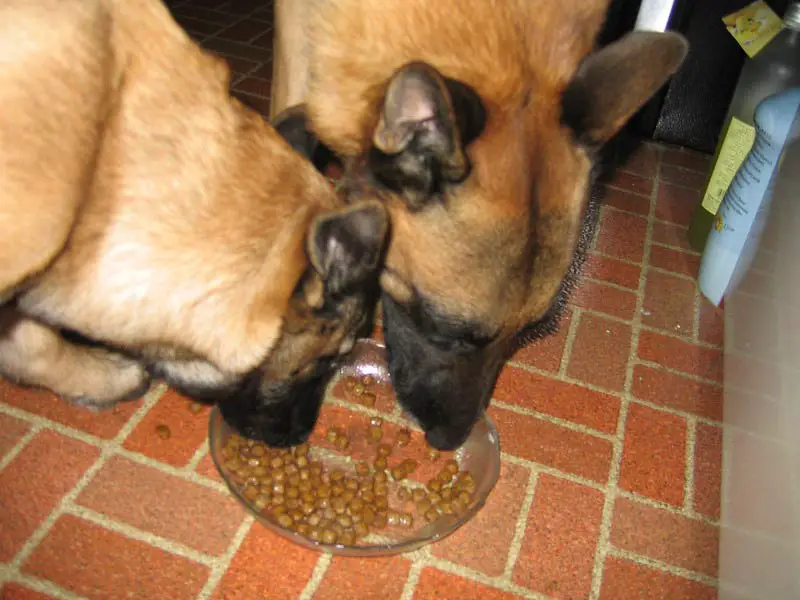
Recommended Food
So, what should you feed a Belgian Malinois? Here are some note-worthy must-haves on their diet plan to keep them healthy and strong:
1. Foods rich in glucosamine
The Belgian Malinois is a breed that’s prone to hip and elbow dysplasia, which can develop over time. This is why you’ll need to counter it from happening by giving your Belgian Malinois foods rich in glucosamine and chondroitin.
These can be found in most organic dog food brands nowadays so you don’t have to search for them that much. However, it is also found in most seafood such as crabs, shrimp, lobster, and shellfish. Therefore, if you want to go on a raw diet for your Belgian Malinois, you can include most seafood.
2. Foods rich in vitamin A and DHA
Since the Belgian Malinois is prone to progressive retinal atrophy and other eye problems such as cataracts, they will need foods rich in vitamin A, such as carrots and other veggies. You can also find vitamin A in other foods such as egg yolks and fish liver oil.
Foods with naturally-occurring DHA can help with both the eyes and the brain development of your puppy. Fish products (fish oil, meal, and the like), sardines, salmon, and other similar foods all contain DHA for your dog’s health.
3. Protein sources like meat
Raw meat is greatly recommended by most breeders for the Belgian Malinois due to their tendency to have hip and elbow dysplasia. It is a bountiful source of glucosamine and chondroitin. You can give them a wide range of protein sources such as chicken, beef, and even organ meat such as animal liver.
Foods to Avoid
What you want to avoid for a Belgian Malinois, aside from chocolate and other no-no’s for dogs, is anything that has too many filler carbs such as wheat, soy, and corn. Most pet owners also advise against white rice and feed their dogs brown rice instead.
Aside from that, it’s best to stay away from foods that have too many additives, colorings, flavors, and the like. This is also why Belgian Malinois pet owners tend to lean towards raw feeding to give them a break from these unnecessary and unhealthy fillers in their dog’s diet.
FAQs on Feeding a Belgian Malinois
To help you manage your Belgian Malinois diet, here are some frequently asked questions about feeding them:
How do I choose the right food for my Belgian Malinois?
When choosing Belgian Malinois food, you should consider the following criteria:
Age of dog
Adult, senior, and puppy diets all differ because of their activity levels and metabolism. Usually, an adult Belgian Malinois that’s more active or an adolescent will need more food. On the other hand, a Belgian Malinois that mostly stays at home, such as a senior, will need a different diet plan.
Weight
Consider the weight of your Belgian Malinois before choosing and scheduling your food. It’s best to consult your vet if you aren’t sure how much to feed based on the Belgian Malinois’ weight. In some cases, age and weight ratio balance may also come into play.
Activity levels
Is your Belgian Malinois dog active all day or do they slouch with you in front of the TV or computer? The activity levels of your canine friend will dictate just how much food you should feed them. If your dog is burning a lot of calories and energy, it will need to be fed more often.
Health concerns
Certain dogs may have underlying health issues. We advise you to talk to your vet and/or breeder to find out any health concerns that may require a different diet for your Belgian Malinois, such as allergies to food and the like.
Should I give my Belgian Malinois treats?
Yes, but in moderation. The Belgian Malinois can be given treats when you train them. Whenever you give them treats, be sure to list them down on your dog’s daily calorie intake to avoid going overboard with the calories and causing your dog to get obese.
Raw feeding a Belgian Malinois
As mentioned above, raw feeding is strongly advised by breeders and pet owners for the Belgian Malinois since they are prone to hip and elbow dysplasia. They need glucosamine-rich foods plus they also need quality food from puppyhood to adulthood to fight off illnesses.
Ground bones are okay to be fed to a Belgian Malinois, so long as they are not too brittle or sharp to cause injuries when eating. When choosing the ingredients for your dog on raw feeding, always keep them fresh and properly handled to avoid contamination of the meat and veggies.
Conclusion
To wrap it up, a Belgian Malinois will live longer and happier if you choose the right food for them, as well as schedule their feedings properly. A Belgian Malinois will be prone to certain illnesses so it’s important to feed them with the right ingredients and nutrients.
We hope that this guide will help you to feed your Belgian Malinois to keep them healthy from their puppy years to adulthood!
